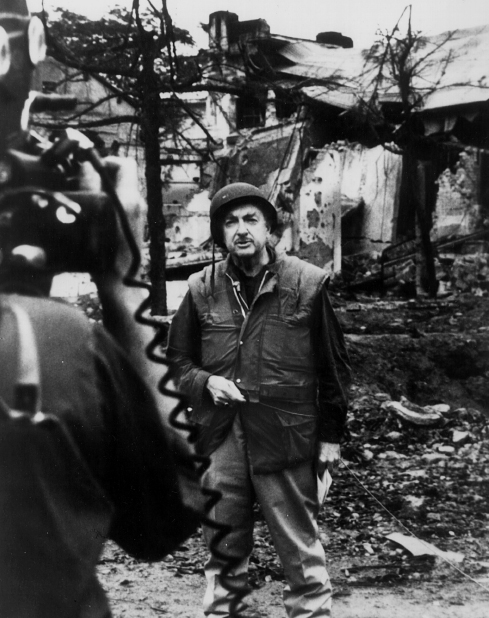TV Information: Our Daily News Culture
Since the 1960s, broadcast news, especially on local TV stations, has consistently topped print journalism in national research polls that ask which news medium is most trustworthy. Most studies suggest this has to do with television’s intimacy as a medium—its ability to create loyalty with viewers who connect personally with the news anchors we “invite” into our living rooms each evening. Print reporters and editors, by comparison, seem anonymous and detached. In this section, we focus on the traditional network evening news, its history, and the changes in TV news ushered in by twenty-four-hour cable news channels.
Network News

Originally featuring a panel of reporters interrogating political figures, NBC’s weekly Meet the Press (1947– ) is the oldest show on television. Daily evening newscasts, though, began on NBC in February 1948 with the Camel Newsreel Theater, sponsored by the cigarette company. Originally a ten-minute Fox Movietone newsreel that was also shown in theaters, it was converted to a live, fifteen-minute broadcast and renamed Camel News Caravan in 1949. In 1956, the Huntley Brinkley Report debuted with Chet Huntley in New York and David Brinkley in Washington, D.C. This coanchored NBC program became the most popular TV evening news show at the time and served as the dual-anchor model for hundreds of local news broadcasts. After Huntley retired in 1970, the program was renamed NBC Nightly News. A series of anchors and coanchors followed before Tom Brokaw settled in as sole anchor in September 1983. He passed the chair to Brian Williams following the 2004 presidential election.
Over at CBS, their flagship evening news program, The CBS-TV News with Douglas Edwards, premiered in May 1948. In 1956, the program became the first news show to be videotaped for rebroadcast on affiliate stations (stations that contract with a network to carry its programs) in Central and Western time zones. Walter Cronkite succeeded Edwards in 1962, starting a nineteen-year run as anchor of the renamed CBS Evening News. In 1963, Cronkite anchored the first thirty-minute network newscast on which President John Kennedy appeared in a live interview—twelve weeks before his assassination. In 1968, Cronkite went to Vietnam to cover the war there firsthand. He concluded, on air, that the American public had been misled and that U.S. participation in the war had been a mistake. Some critics believe his opposition helped convince mainstream Americans to oppose the war.
Retiring in 1981, Cronkite gave way to Dan Rather, who anchored the network’s evening news for twenty-four years. In 2006, CBS hired Katie Couric to serve as the first woman solo anchor on a network evening news program. But with stagnant ratings, she was replaced in 2011 by Scott Pelley.
After premiering an unsuccessful daily program in 1948, ABC launched a daily news show in 1953, anchored by John Daly—the head of ABC News and the host of CBS’s evening game show What’s My Line? After Daly left in 1960, John Cameron Swayze, Peter Jennings, Harry Reasoner, and Howard K. Smith all took a turn in the anchor’s chair. In 1976, ABC hired Barbara Walters away from NBC’s Today show, gave her a $1 million annual contract, and made her the first woman to coanchor a network newscast.
In 1978, ABC World News Tonight premiered, featuring four anchors: Frank Reynolds in Washington, D.C., Jennings in London, Walters in New York, and Max Robinson in Chicago. Robinson was the first black reporter to coanchor a network news program. In 1983, Jennings became the sole anchor of the broadcast. After Jennings’s death in 2005, his spot was shared by coanchors Elizabeth Vargas and Bob Woodruff (who was severely injured covering the Iraq war in 2006) until Charles Gibson—from ABC’s Good Morning America—took over in 2006. Gibson retired in 2009 and was replaced by Diane Sawyer, who formerly worked for CBS’s 60 Minutes and ABC’s Good Morning America.
Cable News Changes the Game
The first 24/7 cable TV news channel, Cable News Network (CNN), premiered in 1980 and was the brainchild of Ted Turner, who had already revolutionized cable with his Atlanta-based superstation WTBS (Turner Broadcast Service). It wasn’t until Turner launched the Headline News channel (now called HLN) in 1982, and turned a profit with both it and CNN in 1985, that the traditional networks began to take notice of cable news. The success of CNN revealed a need and a lucrative market for twenty-four-hour news. Spawning a host of competitors in the United States and worldwide, CNN now battles for viewers with other twenty-four-hour news providers, including the Fox News Channel, MSNBC, CNBC, EuroNews, Britain’s Sky Broadcasting, and millions of Web and blog sites, like Politico, the Huffington Post, the Drudge Report, and Salon.
Cable news has significantly changed the TV news game by offering viewers information and stories in a 24/7 loop. Viewers no longer wait until 5:30 or 6:30 P.M. to watch the national network news stories. Instead, cable channels offer viewers news updates and breaking stories at any time, plus constant online news updates. Cable news also challenges the network program formulas. Daily opinion programs such as MSNBC’s Rachel Maddow Show and Fox News’ Sean Hannity Show often celebrate argument, opinion, and speculation over traditional reporting based on verified facts. These programs emerged primarily because of their low cost compared with that of traditional network news. After all, it is cheaper to anchor a program around one “star” anchor and a few guests than to dispatch expensive equipment and field reporters to cover stories or finance worldwide news bureaus. But at the same time, satirical “fake news” programs like The Daily Show with Jon Stewart and The Colbert Report present a challenge to traditional news outlets by discussing the news in larger contexts, something the traditional daily broadcasts may not do. (See Chapter 14 for more on “fake news” programs.)